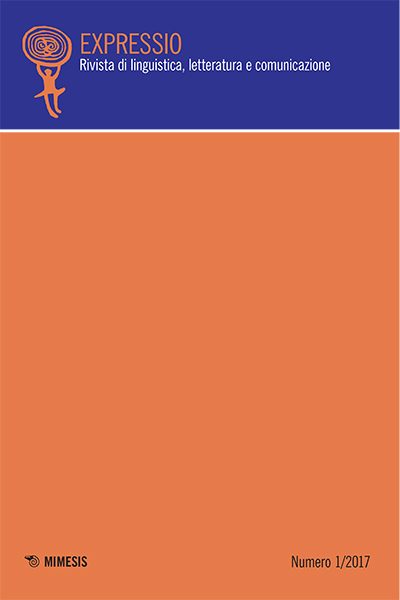Autorizzazione del Tribunale di Varese n. 1 del 2016
9788857541341
2532-439X
Annual
Linguistica e Comunicazione
Double blind peer review
1. GENERAL DUTIES AND RESPONSIBILITIES OF EDITORS
1.1. Editors should be accountable for what is published in their journal. This means they should:
1.1.1 strive to meet the needs of readers and authors;
1.1.2 strive to constantly improve their journal;
1.1.3 have processes in place to assure the quality of the material they publish;
1.1.4 promote freedom of expression;
1.1.5 preclude business needs from compromising intellectual and ethical standards;
1.1.6 always be willing to publish corrections, clarifications, retractions and apologies when needed.
2. RELATIONS WITH READERS
2.1. Readers should be informed about the affiliated institution and who has funded research.
3.1. Editors’ decisions to accept or reject a paper for publication should be based on the paper’s scientific relevance, originality and clarity, and the study’s validity and its relevance to the scopes of the journal.
3.2. Editors should not reverse decisions to accept submissions unless serious problems are identified with the submission.
3.3. New editors should not overturn decisions to publish submissions made by the previous editor unless serious problems are identified.
3.4. A description of peer review processes should be sent, and editors should be ready to justify any important deviation from the described processes.
3.5. Editors should publish guidance to authors on everything that is expected of them. This guidance should be regularly updated.
4. RELATIONS WITH REFEREES
4.1. Editors should provide guidance to reviewers on everything that is expected of them including the need to handle submitted documents in confidence.
4.2. Editors should require reviewers to disclose any potential competing interests before agreeing to review a submission.
4.3. Editors should have systems to ensure that peer reviewers’ identities are protected unless they use an open review system that is declared to authors and referees.
5. RELATIONS WITH EDITORIAL BOARD MEMBERS
5.1. Editors should provide new editorial board members with guidelines on everything that is expected of them and should keep existing members updated on new policies and developments.
6. RELATIONS WITH JOURNAL OWNERS AND PUBLISHERS
6.1. The relationship of editors to publishers and owners is often complex but should be based firmly on the principle of editorial independence.
6.2. Editors should make decisions on which articles to publish based on quality and suitability for the journal and without interference from the journal publisher.
7. EDITORIAL AND PEER REVIEW PROCESSES
7.1. Editors should strive to ensure that peer review at their journal is fair, unbiased and timely.
7.2. Editors should have systems to ensure that material submitted to their journal remains confidential while under review.
8. QUALITY ASSURANCE
8.1. Editors should take all reasonable steps to ensure the quality of the material they publish, recognizing that journals and sections within journals will have different aims and standards.
9. PROTECTING INDIVIDUAL DATA
9.1. Editors must obey laws on confidentiality in their own jurisdiction. Regardless of local statutes, however, they should always protect the confidentiality of individual information obtained in the course of research or professional interactions. It is therefore almost always necessary to obtain written informed consent for publication from people who might recognise themselves or be identified by others (e.g. from case reports or photographs). It may be possible to publish individual information without explicit consent if public interest considerations outweigh possible harms, it is impossible to obtain consent and a reasonable individual would be unlikely to object to publication.
10. DEALING WITH POSSIBLE MISCONDUCT
10.1. Editors have a duty to act if they suspect misconduct or if an allegation of misconduct is brought to them. This duty extends to both published and unpublished papers.
10.2. Editors should not simply reject papers that raise concerns about possible misconduct. They are ethically obliged to pursue alleged cases.
10.3. Editors should make all reasonable efforts to ensure that a proper investigation into alleged misconduct is conducted; if this does not happen, editors should make all reasonable attempts to persist in obtaining a resolution to the problem.
11. INTELLECTUAL PROPERTY AND DEBATE ENCOURAGEMENT
11.1. Editors should be alert to intellectual property issues and work with their publisher to handle potential breaches of intellectual property laws and conventions.
11.2. Editors should encourage and be willing to consider cogent criticisms of work published in their journal.
11.3. Authors of criticised material should be given the opportunity to respond.
11.4. Studies reporting negative results should not be excluded.
12. COMMERCIAL POLICY
12.1. Journals should have policies and systems in place to ensure that commercial considerations do not affect editorial decisions (e.g. advertising departments should operate independently from editorial departments).
12.2. Editors should have declared policies on advertising in relation to the content of the journal and on processes for publishing sponsored supplements.
13. CONFLICTS OF INTEREST
13.1. Editors should have systems for managing their own conflicts of interest as well as those of their staff, authors, reviewers and editorial board members.
13.2. Journals should have a declared process for handling submissions from the editors, employees or members of the editorial board to ensure unbiased review.


La rivista attualmente è presente nell'elenco delle riviste scientifiche per l'area 10 dell'Agenzia Nazionale di Valutazione del Sistema Universitario e della Ricerca (ANVUR) ai fini dell'Abilitazione Scientifica Nazionale.
Università degli Studi dell’Insubria
Università degli Studi dell'Insubria
Università degli Studi dell’Insubria
Università degli Studi dell’Insubria
The paper presents the editio princeps of a new archaic Etruscan inscription written using the granulation technique on a new sanguisuga-type fibula (safety pin) with various decorative patterns in granulation. The interesting text and its analysis allow us to cast new light on other difficult or troubled documents.
Keywords: Etruscan language, Etruscan writing, Etruscan
onomastics
Università degli Studi di Milano
An archaelogical note on the characteristics of the inscribed gold fibula which is epigraphically and linguistically commented in the previous article by G.M. Facchetti.
Università degli Studi dell’Insubria
The article presents a reconsideration of interpretative data, from Thebes tablets, related to Linear B syllabogram *56.
Keywords: Linear B, Mycenaean language
Università degli Studi dell’Insubria
The article is about communicative strategies that non-native speakers apply in order to avoid committing errors in L2 and LS production.
The nature of the errors is very diverse and it is important to understand what the errors are indicators of and what their implications are with the developing system in L2. Errors are divided into many categories and they reveal significant factors such as the level of language and the attitude towards the language, the communicative context, and the learning situation. There are many strategies to avoid such errors and mistakes; speakers are prevalently unaware and smear them to manage the communication for pragmatic and linguistic purposes. Avoiding the communication, leading it to specific unintentional meanings, and using distractors are some of the strategies that speakers use to achieve their communicative goals or react to a specific situation of broken language.
Keywords: errors, L2, pragmatics, linguistics, language education
Università degli Studi di Milano
In the last few years, more and more lexicographic reference tools have been appearing on the Internet with the result that an increasing number of students have been turning away from the more traditional paper and electronic dictionaries. In particular, the linguistic difficulties that collocations give rise to explain why Italian learners of English now often resort to sites such as Just-the-word.com, Phrases.net, Prowritingaid.com, Ozdic.com, Wordreference.com to translate word combinations into English. While there is no doubt that such tools are an important support for language encoding, their value and efficiency must be ascertained, especially in view of the fact that they often come from unknown sources. The aim of the present work is to compare the treatment of collocations in online vs. traditional offline tools, focussing in particular on three criteria: user-friendliness, the amount of word combinations available, and their quality.
Keywords: bilingual lexicography, online dictionaries, collocations, corpus linguistics
Università degli Studi di Cagliari
The present chapter aims to analyse the development of the English language in the United States, looking in particular at the policies and attitudes towards standardization, bilingualism and ethnicity. It will also attempt to observe such development through the study of literary texts, especially for what regards the influence of ethnic dialects into American English.
Keywords: American-English, dialects, standardization, bilingualism, ethnicity
Università degli Studi dell’Insubria
Since the late 1990s, the Italian national healthcare system has been undergoing an administrative decentralisation process from central government to the twenty regions of Italy, mainly in response to a call for greater local autonomy. Consequently, the national level is responsible for ensuring the general objectives and fundamental principles of SSN, whereas regional governments, through the regional health departments, are responsible for ensuring the delivery of healthcare services to citizens. However, national and regional responsibilities are still not clearly defined and health care services are not planned coherently at both levels. Public regional health systems are further divided into smaller local health management organisations called ASLs. This decentralisation process of the Italian National Healthcare System and the jurisdictional conflicts between national, regional and local levels resulted in a fragmentation that has had a deep impact on the effectiveness of communication. This paper investigates the impact of the administrative fragmentation on the multilingual communication of the official websites of the ASLs in the Veneto region. The analysis of the websites is both quantitative and qualitative and covers the following aspects: contents in languages other than Italian, linguistic groups targeted, English as a lingua franca, origin of multilingual contents, communication effectiveness.
Keywords: ELF, multilingual communication, healthcare, Veneto
Università degli Studi di Milano
Università degli Studi dell’Insubria
The aim of this paper was to examine the language used in two digital health encyclopaedias and its ethical implications: NHS Choices’ Health A-Z (http://www.nhs.uk/Conditions/Pages/hub.aspx) and MedlinePlus Health Topics (https://medlineplus.gov/healthtopics.html). Both are offered to the general public
for free by entities sponsored and endorsed by governments. Two sample entries were analysed for this pilot study. One, CANCER, was selected for its relevance as a mass condition, the other, EUTHANASIA / END OF LIFE ISSUES, for its significance in current ethical debates.
The analysis was conducted following methods in Discourse Analysis within an Applied Linguistics perspective. The investigation has identified different linguistic strategies employed when dealing with ethically-connoted health issues as opposed to mass conditions. A focus on the ethics of (healthy) choices also emerged, based on the ample use of the adjective “healthy” and lexicon from the semantic field of healthy lifestyles.
Keywords: medical English terminology, health, ethics, web encyclopaedias, Discourse Analysis
CriFLi, Università degli Studi dell’Insubria
CriFLi, Università degli Studi dell’Insubria
This exploratory study intends to investigate: a) the attitudes towards the musical teaching and educational choices, and the training needs of music teachers using the “Traditional Method” and those using the “Suzuki Method”; b) the parents’ perception of the music teaching method of the school attended by their children (“traditional” versus “Suzuki”), in order to understand the factors of effectiveness and the visible effects on the child from the parent’s point of view.
Quantitative (questionnaires) and qualitative tools (interviews) have been employed. The sample consists of 26 teachers and 83 parents of children attending music schools located in the same geographical and cultural background. Statistical analysis of the questionnaire data shows that Suzuki teachers have positive and confident expectations on all of their students (compared to the control group) and, according to the parents, the different music teaching methods have different effects on the emotions of their children. Content analysis of the interviews shows that all teachers of the sample consider music education a matter of motivation and the role of the adult (parent and teacher) as critical to success in learning. They expressed also the need for a more complete and updated educational and psychological training.
Keywords: music, children, teaching, musical teaching, Suzuki Method
Victoria University of Wellington, NZ
Università degli Studi di Milano
Università degli Studi dell’Insubria
Università degli Studi dell’Insubria
Università degli Studi dell’Insubria

Università degli Studi dell’Insubria
Università degli Studi dell'Insubria
Università degli Studi dell’Insubria